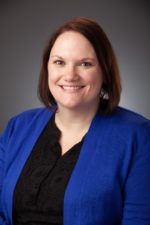Collaborating Makes Our Voice Stronger: Nicole Blankenship, MBA, CAE and Annie Storey, MS, CAE, American Academy of Pediatrics
Association leaders often focus on optimizing resources for the benefit of their members, and Nicole Blankenship, MBA, CAE and Annie Storey, MS, CAE of the American Academy of Pediatrics (AAP) are no exception. Nicole, director of chapter and district relations at AAP, Annie, senior manager for chapter and district relations, and their team of seven manage relationships with 66 AAP chapters across the United States and Canada that build local capacity to implement AAP policies that enhance the well-being of children.
They sat down with Association Adviser to talk about the tools AAP uses to methodically catalog and respond to members’ needs, why they work with an AMC, and how they strive to support members’ ongoing professional needs.
Association Adviser: Tell us about the American Academy of Pediatrics’ mission.

Nicole Blankenship and Annie Storey: The mission of the American Academy of Pediatrics is to attain optimal physical, mental, and social health and well-being for all infants, children, adolescents and young adults. To accomplish this, AAP supports the professional needs of its members.
AA: AAP currently has 66 chapters across the United States and Canada. How does this structure help further your work of attaining optimal physical, mental, and social health and well-being for all infants, children, adolescents and young adults?

NB and AS: Academy chapters are independently incorporated, organized groups of pediatricians and other health care professionals working to advance child health and pediatric practice in their respective communities. They implement AAP policy at the state and local levels. There are 59 United States chapters and seven in Canada. Chapters work in close partnership with the national AAP to achieve common goals, while their autonomy allows them address issues unique to their specific regions/locales. Similar to the national AAP, they respond to the needs of their members and offer advocacy, education, leadership and networking opportunities.
AA: How do you stay in touch with leaders and members across such a wide geographic (and professional) area?
NB and AS: The AAP has a variety of communication tools, as well as various committees, councils, sections and our chapters. These groups help share our messages but also meet the needs of our members so they can continue to be engaged. In 2017 we started a consolidated weekly email digest for our chapter leaders called the “Chapter Leader Link.” It’s a compilation of information from across all AAP departments – announcements, items to promote, upcoming webinars, etc. Chapter leaders know that on Tuesday afternoons, it will be in their email inbox. We know that the Chapter Leader Link has reduced the number of emails that our leaders receive and more than 90 percent of chapter presidents and executive directors read it.
We also host monthly chats with our CEO that feature updates from AAP, advocacy issues, presentations about various AAP programs, and topics that pertain to chapter operational needs. And we developed a collaboration site for chapter leaders where we archive the weekly email digests and post important resources, tools and best practices for chapters.
AA: What strategies or tools do you use to make sure you, as a manager for chapter and district relations, are building the capacity of your chapter leaders to lead the best they can?
NB and AS: One of the best tools that we have is our Chapter Needs Assessment. Since 1997, we’ve conducted this assessment every three years. In 2018, 98 percent of our chapters participated and gave us great insight into what they do at the chapter level but also what resources they need from us. We’ve taken that data, distributed it to AAP staff, and are making programmatic decisions based on that data.
For our internal team, we’ve developed a Plan of Work for this year that focuses on key findings. One of the new programs we are implementing is a quarterly 30-minute web-based orientation for all of the services that the AAP provides to chapters. We find that with the change in our chapter leadership, there is a continual need for education. This series will help share knowledge with our chapter leaders so that when they become chapter president, they are aware of how we can help them.
The other strategy is to listen. From the needs assessment we identified that membership is a key need, but that’s a broad topic. To help us learn what resources are needed at the chapter level, we conducted two virtual focus groups – one for chapter executive directors and one for chapter presidents. Each focus group gave us such great insight because we listened. We hope to host more of these conversations in the future.
AA: What made the American Academy of Pediatrics decide to enlist the help of an Association Management Company?
NB and AS: We know that our chapters vary in strengths and staff capacity. The AAP board of directors was looking for a solution to help chapters build their capacity and focus in on the mission work of the organization. Our staff reviewed various options and ultimately decided that having an association management company as a preferred resource would be the best for our organization.
The chapters provided us with great insight into their operations and needs and that data is what we used to develop an RFP for services. We went the extra step initially and did our homework to find the leading AMC’s that worked with health care clients and would understand the relationship between a national organization and separately incorporated chapters. Kudos to our board and staff for looking at this need critically so that we could find a solution that would meet all of our goals.
AA: What daily operations does your AMC do for AAP? How do they help you with longer-term projects?
NB and AS: This isn’t as easy to answer, as our relationship with the AMC at the national level really is a partnership. We have an MOU that states that WJ Weiser and Associates, Inc. is our preferred AMC. We work to market these services to our chapters. It’s really up to our chapters to take the initiative to call and learn more about how an AMC can provide a solution to their organizational need. We have no financial commitment between the AAP and Weiser. The chapters as separately incorporated organizations have the ability to contract directly with them. We launched this service in November 2018 and within the first two months had ten chapters contact Weiser and two chapters had contracts with them.
AA: Annie, how does your educational background in child, family and youth development inform your work in associations today?
AS: A lot of what we do is about relationships – between departments, organizations, and people. My master’s classes focused on youth policy, programming, and adolescent development. It was completely virtual, so I was able to learn from so many different people working in different types of non-profits, which was probably the greatest gift. I think the biggest takeaway for me is the dissection of the issue – what’s really the problem? And then using innovation to find solutions.
AA: Nicole, you’ve been with AAP for more than 27 years. What are some of the biggest changes you’ve seen in that time with respect to how associations manage relationships with chapters? With vendors or other supporting partners?
NB: We have a really unique partnership with our chapters. We respect their autonomy, yet they look to us as a national organization for guidance and support. We see them as true implementers of AAP policy at the state and local level, and what I have seen throughout the years is an increasing commitment from our national organization to ensure that we are providing chapters with tools and resources to be effective child health advocates and meet the needs of their members at the chapter level.
In terms of how associations in general manage relationships with their chapters, I would say it’s a mixed bag. From my perspective, there is a positive ROI in the case of the AAP. And this idea of investing in chapters has come up over the years, time and time again. As a proponent of chapters, components, affiliates or whatever term is used, I feel that it’s a real opportunity to engage members at the local level, and in that way the chapters become a “breeding ground” for future national leaders. This has definitely been the case with the Academy, and if the relationship is managed right, chapters can be leveraged to carry out critical mission work for the national organization. In turn, most if not all of our chapters report strong relationships with child health advocacy groups in their states and are involved in many coalitions, as is the national AAP.
Collaborating together only makes our voice stronger, so I would have to say that our chapters have really learned to work with others at the local level and in doing so have advanced the health and wellbeing of children in our country, and will continue to do so for years to come.
AA: What do you like best about your jobs?
AS: Beyond the relationship building, I like being a connector. I am able to hear from a variety of chapter leaders, so I can connect people with the same ideas or share what worked for another chapter. This also allows me to hear where the needs are and find solutions that can help all of our chapters.
NB: I have a passion for building capacity, developing relationships and facilitating change, and I get to do those things every day! I also truly enjoy providing leadership development/training to our amazing chapter leaders, and am in constant awe of their efforts to better the lives of the children and families in their states. It’s extremely fulfilling and an honor to work with wonderful professionals at both the national and chapter level.
In terms of work, what keeps you up at night?
AS: To be honest, the AAP is one of the greatest organizations I’ve ever worked for in terms of balance. I am fortunate that I’m not stressing each night about my work. It’s the opposite – I get great ideas at the most random moments, so it’s writing those down at night and then thinking them through the next day!
NB: Like Annie, I wouldn’t say my job keeps me up at night. I just sometimes find myself struggling to prioritize the national and chapter responsibilities that my position requires of me. Every year my small team of seven is responsible for an Annual Leadership Forum, a Chapter Executive Directors’ Conference, five regional district meetings that we plan in conjunction with our board of directors, the resolution process for the organization, and countless other programs, grants and outreach efforts. It’s a bit daunting, but the challenge is exhilarating and professionally satisfying!

